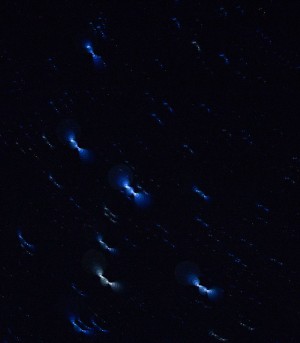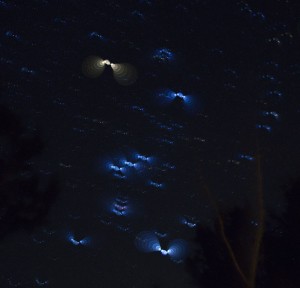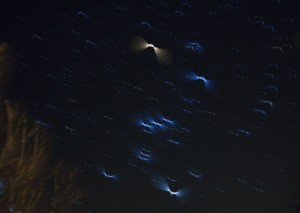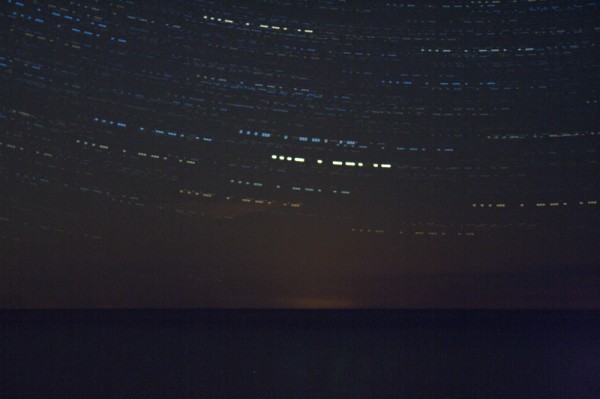I am still at my parents’ summer house in Bønnerup, Jutland. Last night was very beautiful and clear, and I spent more than four hours shooting star trails.
Like the previous night I started by pointing my camera directly at Polaris. This time, however, I programmed my remote timer to take many short exposures in stead of one long exposure. I used an ISO of 400 and maximum aperture. Each exposure was 1 minute long, and there was a gap of 1 second between them. After nearly two hours the battery in my camera died and left me with 117 images.
I used Photoshop to stack the images. On a few of them an airplane had passed through or a speck suddenly appeared but I decided to use them anyway to avoid creating gaps in the star trails. I think the specks might have been satellites passing through. According to Stellarium the satellite Radio Sputnik 15 was roughly in the same position at the same time as this speck:

The first hour’s worth of images produced the following star trails:
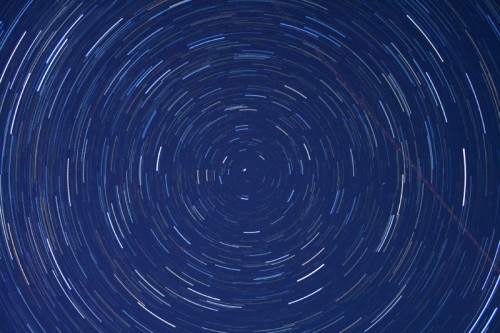
Pretty, isn’t it? :) I especially like how the different colours of the stars stand out. The bright blue-white stars in the top left corner are part of the Cassiopeia constellation, and the single bright white star all the way to the right is part of the Big Dipper.
After nearly two hours the star trails looked like this:
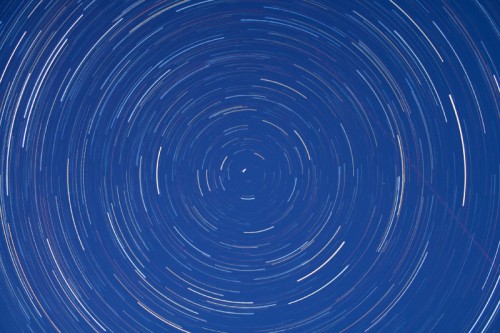
For some reason the background in the second half of the images was a lot lighter than the background in the first half of the images. I suspect it had something to do with the camera getting warmer and thus producing more noise. The two hour long star trails did not stand out as much as the one hour long star trails did, but they were long! :)
When the camera battery had recharged I pointed the camera west towards a group of trees. Time for some scenic star trails! Repeating the procedure from last time, I took a series of 1 minute long exposures. After shooting 79 images the camera’s battery died again. When I went to get the camera I noticed that the camera and the tripod were covered in rime and that the lens was all fogged up. I am just glad the camera toughed it out long enough to take 79 images.
Going through the images in Photoshop I found an airplane in two of the last images. To avoid any gaps in the trails I just removed the last images from the stack which left me with 73 images – more than one hour of action.

I must admit I was amazed by the result. The star trails are so beautiful, and the dark trees really complete the image. It almost looks as though I know what I am doing. ;)
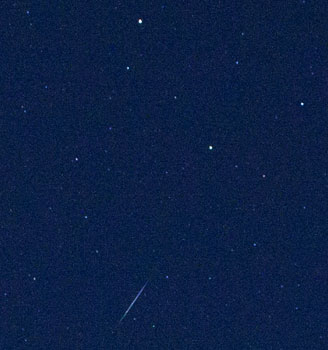 After a bit of fumbling with the focus, I set the camera to take a series of 10 second exposures and stepped back to watch the show. Imagine my joy when a clear meteor shot across the sky right in my field of view! :) I caught a total of three meteors before clouds started drifting in. The first – my first ever! – was also the most luminous. The three most luminous stars in the image are part of the Draco constellation.
After a bit of fumbling with the focus, I set the camera to take a series of 10 second exposures and stepped back to watch the show. Imagine my joy when a clear meteor shot across the sky right in my field of view! :) I caught a total of three meteors before clouds started drifting in. The first – my first ever! – was also the most luminous. The three most luminous stars in the image are part of the Draco constellation.